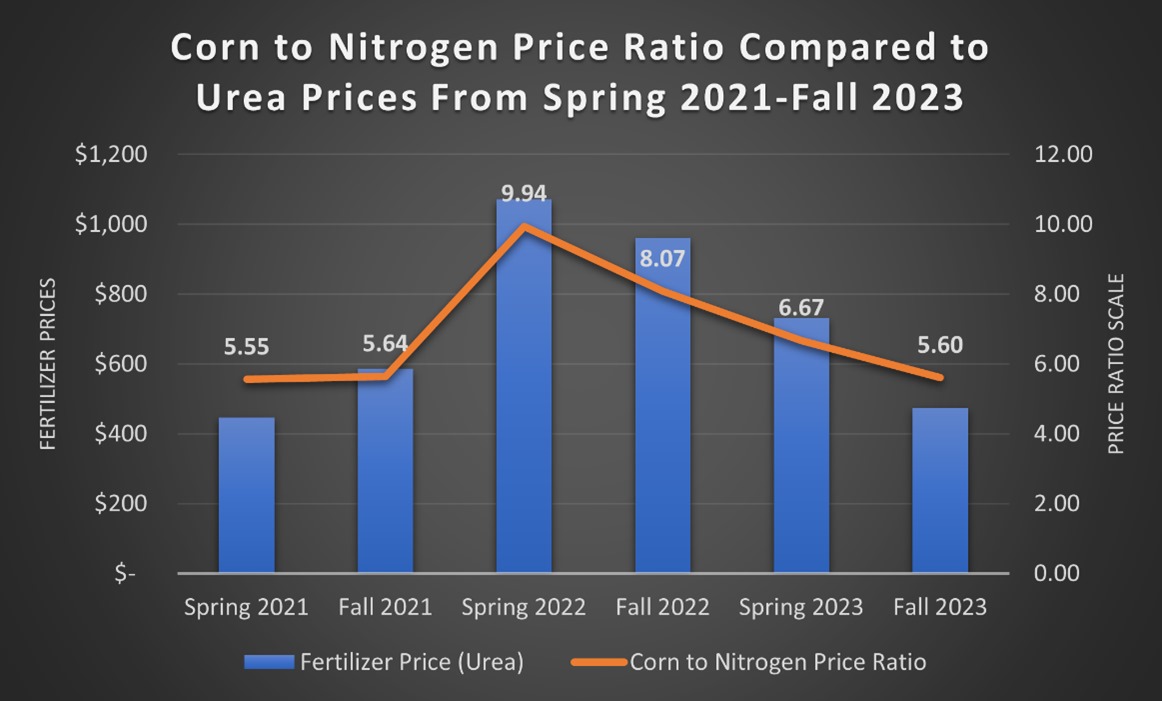By Jonathan LaPorte
Are farm input prices better now or should you wait to make a purchase?
Answering that question presents quite a challenge. Historically, farms that prioritize purchasing inputs early, on average lower total input costs. But this past year revealed better input prices were realized in the spring. As input prices continue to fall, largely driven by lower prices in commodity markets, last year’s strategy may still be a viable option. To decide which approach is right for your farm requires thinking strategically about your buying options.
Understanding market conditions
Understanding market conditions is essential when buying farm inputs. Markets are influenced by a number of different factors, such as supply chains and commodity prices. Recent improvements in supply chains and product availability certainly favor purchases now. Especially when purchases are compared to recent production years.
Declines in commodity market prices have also driven demand for lower input costs. But as market prices decline, concerns of eroding farm profits may increase further demand for lowering costs. If demand is strong enough, it may make waiting to buy a better option.
Long-term commodity projections lean towards lower prices unless production estimates significantly change. A significant change is often brought on by global or domestic events. These events can include global trade, wars, or poor weather, such as drought. Many parts of the country experienced drought in the early summer months. But it remains unclear how drought conditions will impact commodity prices.
When uncertainty exists in the markets, other options to assist decision-making should be explored. One such option is to compare differences between current and historical prices. For fertilizer purchases, a crop to fertilizer price ratio helps consider short-term profits compared to product use. The fertilizer nutrient price ($/lb.) is divided by the crop price. Crop prices are then adjusted to a per pound value. For example, corn prices are divided by 56, while soybeans are divided by 60. A higher price ratio indicates a more expensive fertilizer (see Figure 1 below).

Figure 1. Corn to Nitrogen Price Ratio compared to Urea Prices from Spring of 2021 through Spring of 2023.
In Figure 1, producers in 2022 were better off if nitrogen purchases were made in the Fall versus the Spring (ratio of 5.64 versus 9.94). The opposite was true for 2023 when purchases were better in Spring compared to Fall (ratio of 6.67 versus 8.07). With a ratio of 5.60, at current corn prices, nitrogen prices now are no more costly than they were in 2021. For producers with large nitrogen needs, now may be a time to consider at least some of their fertilizer purchases.
A similar ratio can be used for the consideration of soybean and potassium needs. For more information on crop to fertilizer price ratios, visit the International Plant Nutrient Institute.
Identifying needs and maximizing cash
Each year you develop a crop plan that identifies what you will grow. While crop plans are not a new concept for most farms, they are an important part of maximizing your use of available cash. Cash is often limited to working capital or loan funds. Since they are used for numerous purchases throughout the year, efficient use of these dollars is important.
- To find which options are best for your farm, start with your soil. Soil sampling is critically important to reducing fertilizer costs. You need to know what you’ve got to work with before considering any other decisions. Seed selection and pesticide use are also impacted by your soil and its overall health.
- Are there discounts available on key products? Early purchase or financing discounts are often available for seed and chemistry. Deadlines for each discount should be weighed carefully as you decide what to buy.
- What products are needed in higher amounts? More cash is spent on products needed in large quantities, regardless of when purchases are made. More purchases, with smaller quantities, are recommended to spread potential risk. But targeting large purchase products early maximizes your use of cash to secure them. Especially if purchases use on-farm storage and discounts.
- Are there tax implications to your purchases? Each year, fall purchases are used to offset income tax liabilities. As you plan purchases, remember to maintain flexibility to maximize tax savings this year and next. Don’t overspend this year to save on inputs only to pay more income taxes next year.
- When do you start to market your production? Maximizing cash isn’t just about what you have available now. Locking in favorable prices on production reduces concerns of lower revenues against higher input costs. The key to marketing while purchasing is having a good grasp of your farm’s cost of production.
Prioritizing products to buy
Equally important as maximizing your cash is prioritizing products you’ll buy first. Your crop plans, capital investments you’ve made, and market conditions are all key components of this process.
- Do you have on-farm storage? Farms that invest in product storage need to use them! Physical possession offers security that input needs to be met. Storage facilities also can’t offer a return on your investment if they sit empty.
- Are alternative products available to meet your needs? Consider price differences between what you want to buy and what is available. Especially if alternatives allow you to continue using existing equipment and have minimal impact on application methods.
To help weigh product options, consider utilizing decision tools offered by MSU Extension. The Seed Selection Cost Comparison Decision Tool helps narrow down options that offer yield and profit potential. The Pesticide Cost Comparison Decision Tool for Field Crops helps consider different products and their costs as you plan your IPM strategies. The Fertilizer Cost Comparison Decision Tool helps identify how to meet your nutrient needs at the lowest cost possible.
Source : msu.edu